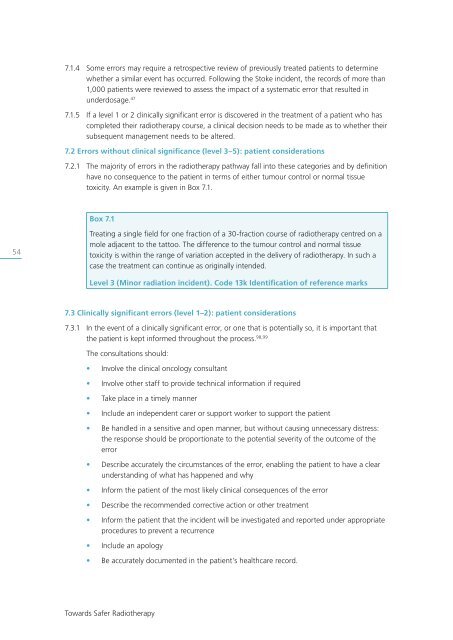Towards Safer Radiotherapy
Towards Safer Radiotherapy
Towards Safer Radiotherapy
You also want an ePaper? Increase the reach of your titles
YUMPU automatically turns print PDFs into web optimized ePapers that Google loves.
7.1.4 Some errors may require a retrospective review of previously treated patients to determine<br />
whether a similar event has occurred. Following the Stoke incident, the records of more than<br />
1,000 patients were reviewed to assess the impact of a systematic error that resulted in<br />
underdosage. 47<br />
7.1.5 If a level 1 or 2 clinically significant error is discovered in the treatment of a patient who has<br />
completed their radiotherapy course, a clinical decision needs to be made as to whether their<br />
subsequent management needs to be altered.<br />
7.2 Errors without clinical significance (level 3–5): patient considerations<br />
7.2.1 The majority of errors in the radiotherapy pathway fall into these categories and by definition<br />
have no consequence to the patient in terms of either tumour control or normal tissue<br />
toxicity. An example is given in Box 7.1.<br />
Box 7.1<br />
54<br />
Treating a single field for one fraction of a 30-fraction course of radiotherapy centred on a<br />
mole adjacent to the tattoo. The difference to the tumour control and normal tissue<br />
toxicity is within the range of variation accepted in the delivery of radiotherapy. In such a<br />
case the treatment can continue as originally intended.<br />
Level 3 (Minor radiation incident). Code 13k Identification of reference marks<br />
7.3 Clinically significant errors (level 1–2): patient considerations<br />
7.3.1 In the event of a clinically significant error, or one that is potentially so, it is important that<br />
the patient is kept informed throughout the process. 98,99<br />
The consultations should:<br />
• Involve the clinical oncology consultant<br />
• Involve other staff to provide technical information if required<br />
• Take place in a timely manner<br />
• Include an independent carer or support worker to support the patient<br />
• Be handled in a sensitive and open manner, but without causing unnecessary distress:<br />
the response should be proportionate to the potential severity of the outcome of the<br />
error<br />
• Describe accurately the circumstances of the error, enabling the patient to have a clear<br />
understanding of what has happened and why<br />
• Inform the patient of the most likely clinical consequences of the error<br />
• Describe the recommended corrective action or other treatment<br />
• Inform the patient that the incident will be investigated and reported under appropriate<br />
procedures to prevent a recurrence<br />
• Include an apology<br />
• Be accurately documented in the patient’s healthcare record.<br />
<strong>Towards</strong> <strong>Safer</strong> <strong>Radiotherapy</strong>



